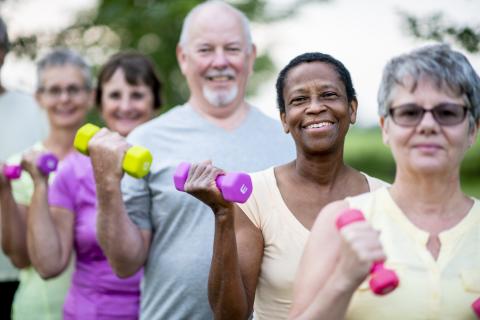Bone Up to Protect Your Bones
What is osteoporosis
The best way to explain osteoporosis is to compare bones to honeycombs. Bones are made up of living tissue. To stay healthy, the body dismantles old bone to build up new bone. This bone tissue has walls and hollow spaces—just like a honeycomb. When more of the old bone is broken down than new bone is created, the spaces inside get larger, with fewer walls. The outer wall, or shell, of the bone also gets thinner. So, the entire structure becomes more fragile.
People with osteoporosis are more likely to break bones and have a harder time recovering. In severe cases, a small bump or cough can cause a fracture. Women are more likely than men to have weakened bones, with women of white or Asian decent to have higher risk for the disease.
How to prevent it
There are several actions you can take to strengthen bones and prevent osteoporosis—and you can start at any time!
- Eat a healthy diet. Include plenty of foods that are rich in protein, calcium, and vitamin D, like dairy, fish, lean meats, fruits, and vegetables. Salty foods as well as caffeine can cause the body to lose calcium and weaken bones. Discuss with your doctor if you need supplements to ensure enough vitamin D.
- Exercise regularly. Weight-bearing and muscle-strengthening activities are key for increasing and maintaining bone density. Try dancing, hiking, and tennis for weight-bearing exercises; lift weights, use elastic exercise bands, and do functional movements to strengthen muscles.
- Limit alcohol and don’t smoke. Heavy drinking can decrease bone density and weaken their mechanical properties; aim for 3 or fewer alcoholic beverages per day. Smoking prevents the body from absorbing calcium causing weaker bones and nicotine slows the production of the bone-forming cells for healing.
How osteoporosis is diagnosed and treated
Many seniors don’t know they have osteoporosis until they break a bone. But health care providers can examine how strong bones are with a bone density scanner. The test result is called a T-score and compares the scanned bones with that of an average healthy adult. Questionnaires, ultrasounds, and physical exams may also be part of diagnosis and predict future risk of the disease and fractures.
Treatment focuses on preventing additional bone density loss as well as bone breaks. All of the actions listed above for preventing the disease will help but may not be enough. Medications are available that slow down bone loss or help rebuild bone; individually or together, they work to repair damage caused by osteoporosis.
Healthy bones are an important part of healthy aging. Taking time to learn how to support them will ensure that they can support you through life.
